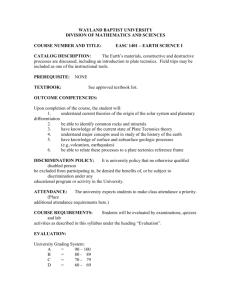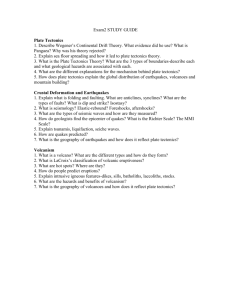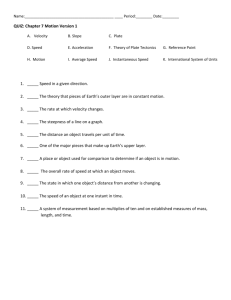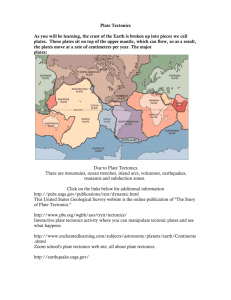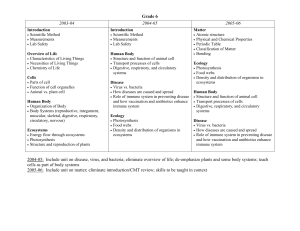Course Outlines NewCURRICULUM3_
advertisement
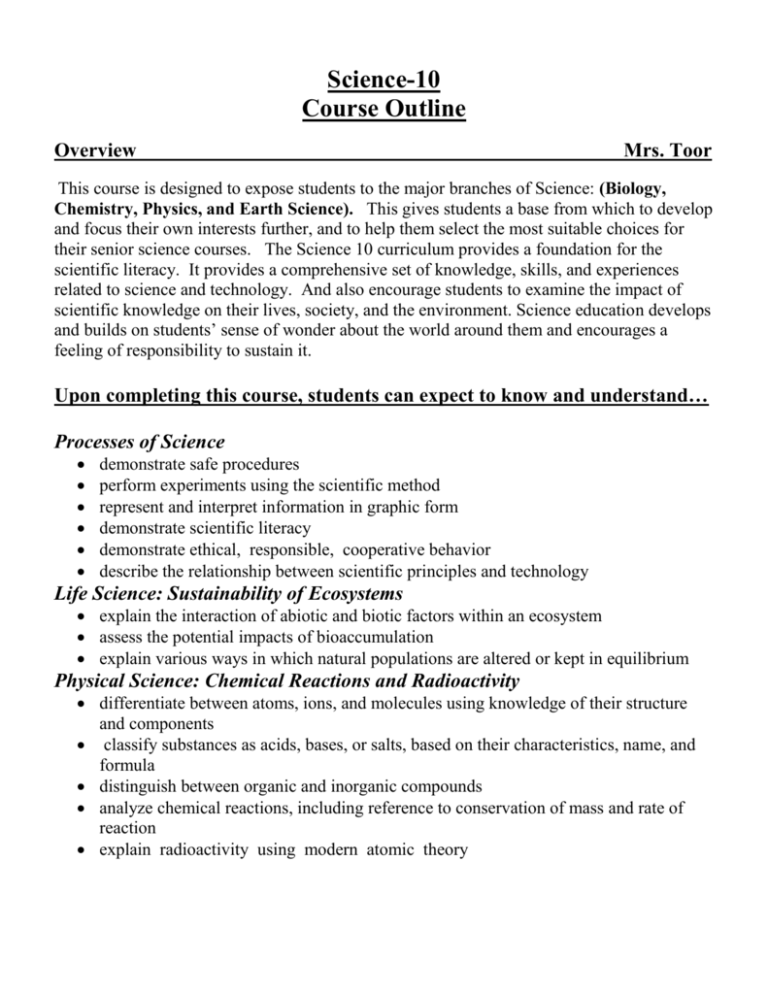
Science-10 Course Outline Overview Mrs. Toor This course is designed to expose students to the major branches of Science: (Biology, Chemistry, Physics, and Earth Science). This gives students a base from which to develop and focus their own interests further, and to help them select the most suitable choices for their senior science courses. The Science 10 curriculum provides a foundation for the scientific literacy. It provides a comprehensive set of knowledge, skills, and experiences related to science and technology. And also encourage students to examine the impact of scientific knowledge on their lives, society, and the environment. Science education develops and builds on students’ sense of wonder about the world around them and encourages a feeling of responsibility to sustain it. Upon completing this course, students can expect to know and understand… Processes of Science demonstrate safe procedures perform experiments using the scientific method represent and interpret information in graphic form demonstrate scientific literacy demonstrate ethical, responsible, cooperative behavior describe the relationship between scientific principles and technology Life Science: Sustainability of Ecosystems explain the interaction of abiotic and biotic factors within an ecosystem assess the potential impacts of bioaccumulation explain various ways in which natural populations are altered or kept in equilibrium Physical Science: Chemical Reactions and Radioactivity differentiate between atoms, ions, and molecules using knowledge of their structure and components classify substances as acids, bases, or salts, based on their characteristics, name, and formula distinguish between organic and inorganic compounds analyze chemical reactions, including reference to conservation of mass and rate of reaction explain radioactivity using modern atomic theory Physical Science: Motion explain the relationship of displacement and time interval to velocity for objects in uniform motion demonstrate the relationship between velocity, time interval, and acceleration Earth and Space Science: Energy Transfer in Natural Systems explain the characteristics and sources of thermal energy explain the effects of thermal energy within the atmosphere evaluate possible causes of climate change and its impact on natural systems Earth and Space Science: Plate Tectonics analyze the processes and features associated with plate tectonics demonstrate knowledge of evidence that supports plate tectonic theory Upon completing this course, students should possess the following skills… Develop a positive attitude towards science Actively gaining knowledge, skills, and attitudes that provide the basis for sound and ethical problem solving and decision making Organizational skills with application to this and other courses Examining basic concepts, principles, laws, and theories through scientific inquiry The ability to work together to solve problems or perform investigations Evaluate danger in particular procedures and equipment, taking responsibility for safety Expertise in producing an appropriate lab report Develop the capacity to think critically Desire to meet a challenge, take risk, and learn from mistakes Throughout this course, the following attitudes will be fostered… An appreciation for the enormous complexity of our world. A basic understanding of the complex interactions that make up an ecosystem, and the delicate balance that is represented by those interactions. An appreciation of the contributions that science makes to our daily lives. An attitude of critical thinking in approaching the many ethical and social issues that relate to science. An enthusiastic interest in learning as an ongoing and active process. Upon completing this course, students should depart with … A broad base of knowledge in basic biology, chemistry, physics and earth science. An ability to manipulate laboratory equipment to perform simple investigations. An appreciation for how science impact our daily lives. A solid foundation in experimental design and analysis. The knowledge, skills and attitudes necessary to continue course work in the grade 11 sciences. Student learning will be assessed as follows: Student notebooks will be assessed for completeness, organization, and quality of work. Laboratory investigations and the written reports from those investigations are a major consideration in assessment. Labs involve a variety of investigative techniques, working both individually and within a group. Proper safety, cooperative interactions, and care of lab equipment are stressed. Notebooks and laboratory work, along with any written assignments comprise 30% of the student mark. Comprehensive exams that test knowledge, understanding and application of information to novel situations comprise an additional 60% of the student mark. A Final Exam that is comprehensive (covering the entire Science-10 course content) is assessed at 10% of the year-end mark. Additional Information: Science 10 is a mandatory course in British Columbia. It is also a prerequisite to all grade 11 and 12 sciences. Science 10 students are required to write Provincial Exam at the end of the term. There are two terms and each is worth 40% and final provincial exam worth 20%. Every science 10 students in the entire province will write this exam at the same time. It is 3 hour exam. COURSE CONTENT Unit 1: Sustaining Earth’s Ecosystems (Biology) Chapters1-3 Interactions in Ecosystems: Intro to Ecology: What is an Ecosystem? Biotic & Abiotic Factors Ecological Roles, Relationships & Symbioses Trophic Levels & Energy Flow: Food Webs & Pyramids Community Ecology: Distribution of Organisms in the Biosphere: World Biomes Adapting to the Environment: Adaptation & Natural Selection Community Interactions: Competition, Invasive Species Succession Cycling of Organic & Inorganic Matter: Photosynthesis & Cellular Respiration Carbon, Nitrogen & Phosphorus Cycles Changing the Balance in Ecosystems: Natural Phenomena Pollutants in Ecosystems Bioaccumulation & Biomagnifications Unit 2: Chemical Reactions (Chemistry) Chapters 4-6 Atoms & Elements: Atomic Structure Atoms vs. Ions Bohr Models Classifying elements on the Periodic Table Chemical Compounds: Ionic Bonding: Simple & Complex Covalent Bonding Inorganic Compounds: Acids, Bases & Salts Organic Compounds Chemical Reactions: Conservation of Mass & Balancing Chemical Equations Types of Chemical Reactions Rates of Chemical Reactions Unit 3: Radioactivity (Chemistry/Physics) Chapter 7 Radioactive Elements: Protons, Neutrons & Isotopes Radioactive Decay: Alpha, Beta & Gamma Decay Half Lives, Decay Series & Radioactive Dating Nuclear Reactions: Fission vs. Fusion Unit 4: Energy Transfers & Plate Tectonics (Earth Science) Chapters 10-12 Temperature, Thermal Energy & Heat: Kinetic Molecular Theory, Conduction, Convection & Radiation Heat Capacity & Changes of State Earth’s Heat Sources Energy Transfer in the Atmosphere Energy Distribution: Temperature & Latitude, Seasons Global Patterns of Wind & Water Climate Change: What is Climate Change? Influences on Climate: Natural & Human Influences Impact of Climate Change Plate Tectonics: Structure of the Earth Evidence of a Dynamic Earth: Continental Drift & Sea-Floor Spreading Plate Tectonics: Cause & Effects Unit 5: Motion (Physics) Chapters 8-9 Distance & Time: Distance vs. Displacement Calculating Velocity Graphing Distance, Time & Velocity Acceleration: Accelerating Objects Calculating Acceleration Graphing Accelerated Motion



